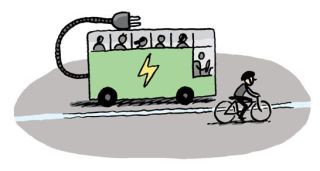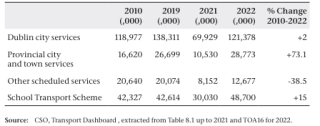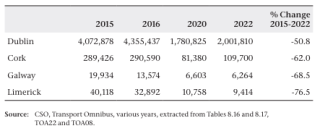Supporting active and green travel

According to the National Household Travel Survey 2022, 69 per cent of all journeys taken in 2022 were by private car. Walking is the second most popular form of transport, accounting for 20 per of trips. Five per cent of trips were made by bus, 2 per cent on bike and 2 per cent for train/DART/Luas journeys. Those in densely populated areas were less likely to use a car than those in thinly populated areas, with private cars accounting for 53 per cent of all journeys in Dublin City and Suburbs, compared to 80 per cent in rural areas. Future housing development must take into account transport links from the earliest planning stage.
Preliminary public transport figures published by the National Transport Authority for 2023 report their busiest ever year across public transport networks with “over 308 million passenger journeys provided by Dublin Bus, Bus Éireann, Iarnród Éireann, Luas, Go-Ahead Ireland and TFI Local Link”. The Transport Dashboard from the Central Statistics Office showed an overall increase in passengers on public transport between 2010 and 2019, decreasing for 2021 due to ongoing Covid-19 related travel restrictions and returning for most services in 2022 (Table 1).
Table 1: Summary of Scheduled Bus Passenger Services 2010 to 2022

In addition to the millions of bus passengers in Dublin city, over 48 million journeys were taken across the two Luas lines in 2022 and a further 24.6 million journeys were made using the Dublin suburban rail and DART services. The bicycle sharing scheme in Dublin saw just over 2 million journeys undertaken in 2022, a slight increase since 2020 but continuing the overall downward trend since 2016. When we compare data since 2015, the year in which all four bicycle schemes were operational, we see a decline in journey numbers (Table 2).
Table 2: Bicycle Sharing Scheme, Dublin, Cork, Galway and Limerick, 2015 to 2022

The bicycle sharing scheme is an excellent initiative and supports environmentally sustainable commuting in urban centres. However, without hard infrastructure for cycle lanes, our continued reliance on private cars for urban commutes makes citycycling hazardous. Social Justice Ireland therefore calls on Government to expedite the introduction of hard infrastructure to support safe cycling in our cities. The lack of reliable public transport in rural areas means that rural households are more reliant on their car to access basic services and commute to and from work and school. This reliance is contributing to our carbon footprint, with transport being one of the three main contributing industries.
Transport Greenhouse gas (GHG) emissions increased by 6 per cent in 2022 and whilst electric vehicles accounted for approximately 19 per cent of all new registrations in 2022, they still only account for approximately 37 per cent (compared to 24% in 2021) of the 2025 policy target of 195,400 or less than 8 per cent of the 2030 policy target of 944,600 electric vehicles.[1] Government expenditure on public transport as a percentage of total land transport expenditure has fluctuated since 2002, reaching a low of 30 per cent in 2006. The proportion of the spending allocation for Carbon Reduction and Public Transport in 2021 was 43 per cent.[2] Infrastructure must be in place to support thinly populated areas to grow and thrive, while those living in Dublin and surrounds, with access to an extensive public transport network, should be encouraged and incentivised to use it. We must improve active travel infrastructure such as walking tracks and cycling lanes, and work towards making these a permanent transport feature in both rural and urban areas.
We must increase the provision of public transport in rural areas and provide greater investment in sustainable transport and biofuels. We also need investment in hard infrastructure for cycle lanes.
[1] https://www.epa.ie/our-services/monitoring--assessment/climate-change/g…
[2] https://www.gov.ie/pdf/?file=https://assets.gov.ie/229104/5370afd1-1f47…
